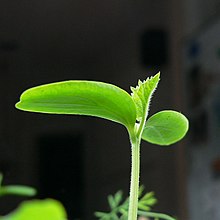Shoot (botany)

Shoots are new plant growth, they can include stems, flowering stems with flower buds, and leaves. The new growth from seed germination that grows upward is a shoot where leaves will develop. In the spring, perennial plant shoots are the new growth that grows from the ground in herbaceous plants or the new stem and/or flower growth that grows on woody plants.

In everyday speech, shoots are often confused with stems. Stems, which are a critical component of shoots, provide an axis for buds, fruits, and leaves.
Shoots are often eaten by animals because the fibres in the new growth have not yet completed secondary cell wall development, this makes shoots softer and easier to chew and digest. As shoots grow and age, the cells develop completed cell walls that have a hard and tough structure. Some plants (e.g. bracken) produce toxins that make their shoots inedible or less palatable.

See also
- Stem
- Bud
- Lammas growth a second burst of growth late in the growing season exhibited by some trees.
- Lateral shoot
External links
